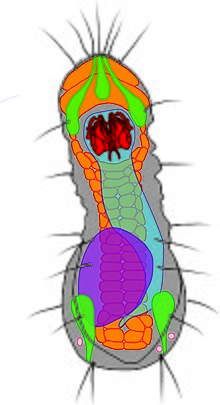Limnognathia
| Limnognathia | |
|---|---|

| |
| Schematic drawing of Limnognathia maerski | |

| |
| Microscopic on L. maerski | |
| Scientific classification | |
| Domain: | Eukaryota |
| Kingdom: | Animalia |
| Subkingdom: | Eumetazoa |
| Clade: | ParaHoxozoa |
| Clade: | Bilateria |
| Clade: | Nephrozoa |
| (unranked): | Protostomia |
| (unranked): | Spiralia |
| Clade: | Gnathifera |
| Phylum: | Micrognathozoa |
| Order: | Limnognathida |
| Family: | Limnognathiidae |
| Genus: | Limnognathia |
| Species: | L. maerski
|
| Binomial name | |
| Limnognathia maerski Kristensen & Funch, 2000
| |
Limnognathia maerski is a microscopic acoelomate freshwater animal, discovered living in warm springs on Disko Island, Greenland, in 1994.[1] Since then, it has also been found on the Crozet Islands of Antarctica[2] as well as in the British Isles,[3] suggesting a worldwide distribution, although there are likely different species yet to be described.
With an average length of 100 micrometers (μm), it is one of the smallest known animals.
Etymology of Micrognathozoa: From the Greek Micros (= very small) Gnathos (= jaw) and Zoon (= animal)
L. maerski is the only species that belongs to the Micrognathozoa, a relatively new phylum of animals that was only described in 2000. [4][5]
Description
Feeding
L. maerski mainly feeds on bacteria, blue-green algae, and diatoms. It has very complex jaws, with fifteen separate elements; these elements are very small, ranging from 4 μm to 14 μm. The animal can extend part of its jaw structure outside its mouth while eating. It also extends much of its jaw structure outside its mouth when it is regurgitating indigestible items.
Anatomy
L. maerski has a large
Flexible cilia are arranged in a horseshoe-shaped area on the forehead, and in spots on the sides of the head and in two rows on the underside of the body. The cilia on the forehead create a current that moves food particles towards the mouth. The other cilia move the animal.
Reproduction
All specimens of L. maerski that have been collected have had
Taxonomy and phylogeny
Taxonomic status
Limnognathia maerski is nominally a
Phylogeny
Cladogram[8] showing the relationships of Limnognathia:
Gnathifera
|
| ||||||||||||||||||
The Gnathifera is the sister group to the rest of the spiralians and is crucial to understand because of its relationship to animal evolution.
References
- ^ Gastrotricha and Gnathifera
- .
- ^ Worsaae and Kristensen, 2016
- ^ Nielsen and Claus, 2013 :Nielsen, Claus, 'Phylum Micrognathozoa', Animal Evolution: Interrelationships of the Living Phyla, 3rd edn (Oxford, 2011; online edn, Oxford Academic, 17 Dec. 2013), https://doi.org/10.1093/acprof:oso/9780199606023.003.0033, accessed 28 Jan. 2024./
- ^ https://earthlife.net/micrognathozoa
- PMID 21708760.
- ^ Gordon, Dennis P. (2009). "Towards a management hierarchy (classification) for the Catalogue of Life". In Bisby, F.A.; Roskov, Y.R.; Orrell, T.M.; Nicolson, D.; et al. (eds.). Species 2000 & ITIS Catalogue of Life (Draft discussion document). 2009 Annual Checklist. Reading, UK: Species 2000. Archived from the original (CD-ROM) on 8 August 2009.
- ^ "Phylogeny". zmuc.dk. 14 December 2005. Archived from the original on 24 December 2018. Retrieved 3 March 2018.
External links
- "Limnognathia introduction". zmuc.dk. Københavns Universitet (University of Copenhagen). Archived from the original on 2 December 2019. Retrieved 10 December 2021. — Comprehensive information on L. maerski
- "Jaws: New animal discovered". Science Now. Natural History Museum. California Academy of Sciences. c. 2006. Archived from the original on 23 March 2007. — article on L. maerski
- Bekkouche, Nicolas; Worsaae, Katrine (1 October 2016). "Nervous system and ciliary structures of Micrognathozoa (Gnathifera): Evolutionary insight from an early branch in Spiralia". Royal Society Open Science. 3 (10): 160289. PMID 27853545.
